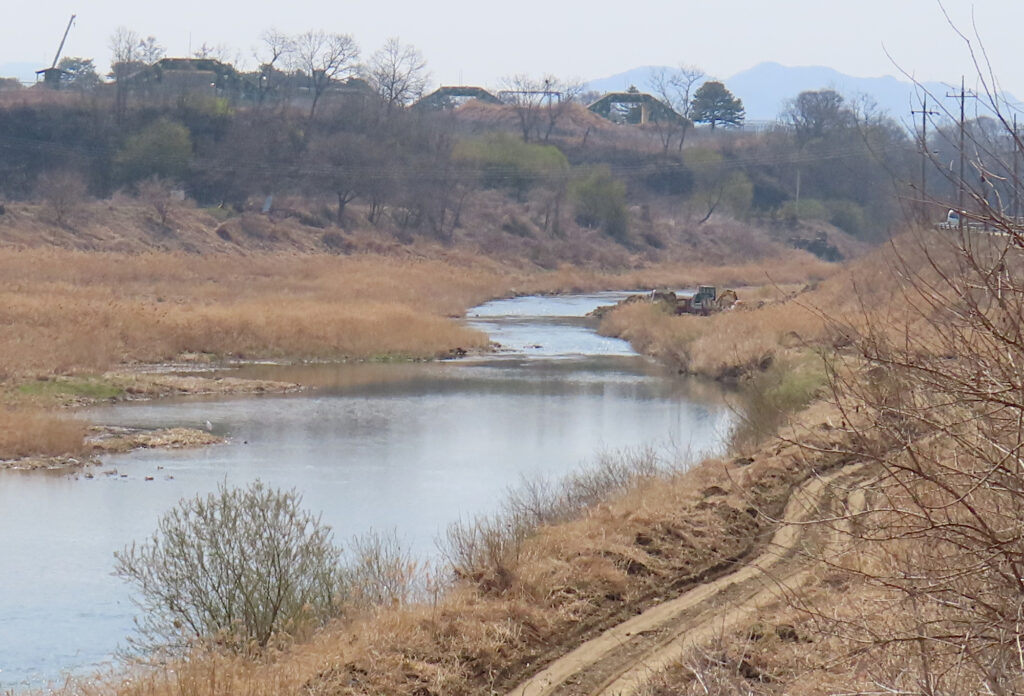A guest post by Park Shinyeong, PhD Candidate University of Georgia and Birds Korea Intern (March-June 2024).

Hi, I’m Park Shinyeong, a PhD student studying integrative conservation at the University of Georgia, United States. I participated in Long-billed Plover Charadrius placidus surveys with Birds Korea and Birds Korea Yeoncheon as an intern. Since Birds Korea’s mission to contribute to conservation through research aligns with my position as a researcher, I saw this as a valuable opportunity to learn about current conservation issues in the Yeoncheon area and collaborate with local experts. Although the internship was short, it was an invaluable experience that exceeded my expectations and taught me to appreciate the beauty and preciousness of our natural environment. I would like to take this opportunity to express my deepest gratitude to Dr. Nial Moores and the Birds Korea Yeoncheon team.
This spring, I spent several days in spring surveying Long-billed Plovers, a nationally threatened bird species. Threatened species are those facing major challenges in maintaining their populations, often due to habitat change caused by human activities. The designation of ‘threatened species’ highlights the urgent need to address biodiversity loss and protect the species, necessitating changes in human behavior to support their survival. However, our survey revealed a tragic reality: the necessary changes are not being made.
In March, during the mating and incubation period, Long-billed Plovers carefully move around the wide, flat, shingle terrain on the river, perfectly camouflaged. Despite it being the season for mating and nest-building, finding a good spot is quite challenging due to fishers, campers, and predatory birds that no longer migrate with the changing seasons. On the open, vegetation-free shingle field, with no distinct nest, the Long-billed Plover couple cautiously lays and guards their eggs. The eggs, resembling shingle stones, are hard to distinguish from the surroundings. To avoid predators like snakes, crows, and herons, the Long-billed Plover couple makes alarm calls and pretend to be injured, doing their best to protect their nest.


After confirming the presence of Long-billed Plovers at over 30 locations in Yeoncheon, we returned in May to look for families that had entered the chick-rearing phase. Everywhere we looked, construction was in progress, with clear signs of excavators digging up the riverbed and heavy machinery sweeping through the river for civil engineering work. Even before we could meticulously scan each shingle bank through the telescope, we couldn’t help but sigh, wondering if the Long-billed Plovers could have laid their eggs in such a disturbed area, and if they did, whether the eggs could have survived and hatched safely. River dredging, tree removal along the riverbanks, road expansion, and various other construction activities were taking place for multiple reasons, making it difficult to find Long-billed Plovers in such heavily disturbed areas. Ultimately, we were only able to confirm the presence of Long-billed Plover families at only six out of the 30 locations.

The river-works were likely undertaken to “manage” rivers, enhancing their utility as water resources, preventing flood damage, avoiding additional harm from vegetation establishment (or even protecting native ecosystems from invasive species?). Roads were built along the shortest route and heavy machinery crossed the rivers to reduce construction costs, and walkways were created alongside rivers to bring people closer to nature. However, these well-intentioned actions could be more effectively realized by considering the lives of organisms inhabiting the river ecosystems. Since the world is not solely for humans, it’s crucial to take care of other life forms. Prioritizing human needs also can be achieved when addressing ecological concerns. The loss of biodiversity and the resulting collapse of ecosystem structures will ultimately lead to higher costs than we initially aimed to save, and it will be difficult to restore the lost balance. Although there seems to be a shared understanding of the importance of our world, the cycles of ecosystems, and the significance of a healthy social structure, many of our society’s decisions are still driven by short-sighted cost-benefit analyses and contradictory policies.
Even though most people are unaware of the existence of Long-billed Plovers; there is no doubt that these birds are members of our society. The world they have helped shape is the very same world we live in, and it is a world that humans must protect for their own survival. From daily life to policy-making, we need a holistic perspective that considers these creatures who live “separately yet together” with us. Urban planning and “ecosystem management” for human convenience should not only consider the costs and immediate benefits to humans but must also take into account the flora and fauna affected by human decisions. With careful consideration and decision-making, we can significantly improve the lives of Long-billed Plovers, which in turn will enhance human life and our community as a whole.
The designation of threatened species raises awareness about the species and their ecosystems, providing an opportunity to reflect on and strive for a better way of life. Species like cranes attract attention from academia, the public, and the government, leading to active efforts to expand their habitats. However, many threatened species remain outside the spotlight, with their populations rapidly declining toward extinction. This internship reminded me that we live in a time when it is no exaggeration to say that the fate of these species lies in human hands. It is more important than ever to study and research the various life forms, understand where and how they live, and ensure that many people are aware of this knowledge and take action to protect them.

Closing Comment: Birds Korea would also like to express our heartfelt thanks to PhD Candidate Park Shinyeong for all of her hard work and important contributions to the research on Long-billed Plovers and planning for the proposed Jeongok Wetlands Park during her internship – all deeply appreciated! All success to you in your doctoral program and we look forward to working with you again in the future!
